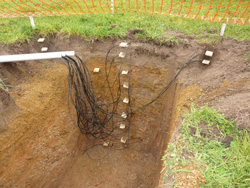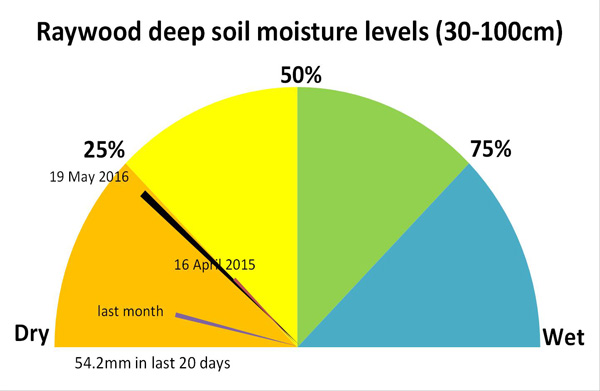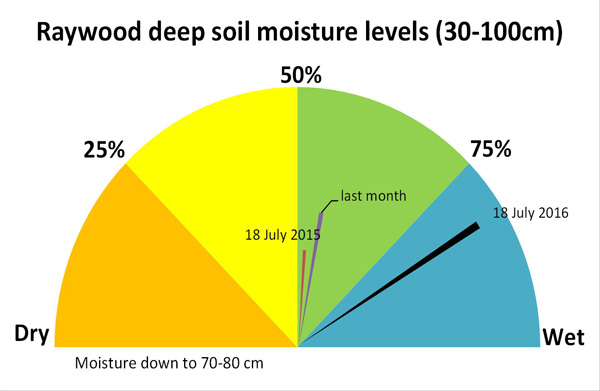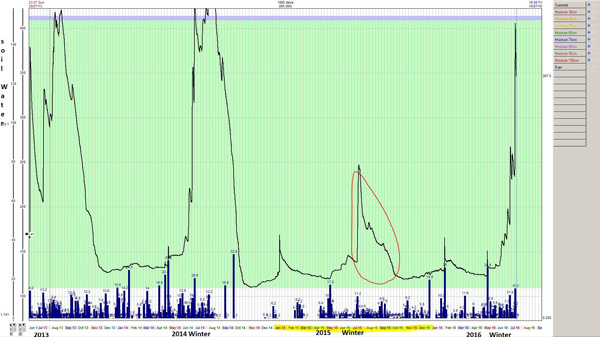Using soil moisture to make strategic decisions

As livestock and grain producers face increasing seasonal variability, up-to-date information on soil moisture is becoming highly valued in support of tactical decision making. This has been shown by the use of the department's soil moisture probe network by the Victorian dryland grains industry to make a range of farm decisions over the past six seasons.
Each site is monitored using capacitance probes which take hourly measurements of soil water content through the soil profile. Sensors in the capacitance probe measure 10cm soil zones, from a depth of 30cm down to 1m.
Repeatable measurements from each sensor are recorded at the site, and the data collected are sent via the mobile phone network to a server, which stores the data to allow interpretation using graphing software.
And the story continues to get better, with progressively better data being generated in new and varied seasons. Knowledge of deep soil moisture conditions can help the grains industry make tactical decisions about:
- crop types sown
- time of sowing
- upfront and in-crop management inputs (particularly nitrogen)
- crop salvaging for hay in dry years
- grain marketing.
Potential uses for livestock graziers include decisions about:
- selling or buying livestock early
- purchasing supplementary feed
- nitrogen applications.
By far the most important use is in making decisions about inputs — for example, minimising input in years with a low soil moisture base, and maximising yield potential under more favourable conditions. This is based on current soil moisture levels, understanding of Victoria's climate drivers and incorporation of seasonal forecast probabilities.
A soil moisture speedo is used to show how the season is progressing, with the gauge needles showing changes in the past month and comparing the conditions with those of a year ago. Cropping confidence improves when the needles increase in May to August, indicating that rainfall exceeds plant demands and builds up moisture reserves that can be used later for critical crop growth periods (flowering and grain fill).


How can pasture and sheep producers use this type of technology to make informed tactical decisions?
Some great research and extension has already been conducted in south-west Victoria by Malcolm McCaskill, examining soil moisture and pasture production. This will be validated at the Lake Bolac monitoring site in the coming years. The Lake Bolac site has been sown down to pasture this season after five years of monitoring winter crop and soil — water interactions.
This is a unique opportunity to compare historical annual versus perennial plant growth and moisture use, and the effect of canopy management associated with grazing systems. Winter crops in spring, with a large biomass and available soil moisture, can deplete large moisture reserves. What will the pasture moisture use be like?
The farmer host hopes that pasture growth continues to mid to late December because then sheep can go onto crop stubbles. Early signals from the moisture probes of soil moisture conditions can provide indications of pasture production because half the spring production is based on soil moisture, with the other half coming from rainfall. Fortunately, knowledge of both of these has improved, which is where the moisture probes in pasture situations could have a great fit.

Yellow highlights in the x axis date sequence shows the dry year of 2015 and the red marker indicates the limited deep soil moisture accumulated in that year. The green shaded area is plant available water and this site has consistently obtained maximum water holding in most winters.
One decision that could be considered with knowledge of soil moisture levels is the culling rate of sheep in August, when the feed outlook identifies feed gaps. Urea application can also be a strategy in dry springs, such as 2015, to increase feed production during the period of reliable soil moisture, and to boost hay and silage yields. Nitrogen application should be considered as part of the feed budget rather than the fertiliser budget, because it is an alternative for supplying additional feed at times of forecast shortage.
Live data for all Agriculture Victoria crop and pasture sites, including moisture speedos and soil temperature is available on the ExtensionAus website.